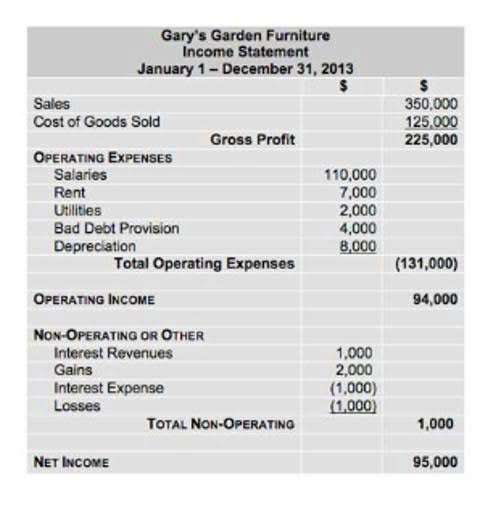
The objective is to present clear and easily readable reports, and what are unrestricted net assets not to make the reader work hard to figure it out. When I set up a new QuickBooks file for an (existing) non profit, I entered the opening balance for the checking account, which went into “Opening Balance Equity”. From reading other questions here, I learned that Opening Balance Equity is supposed to be a temporary account, and that the balance should be moved to another equity account. Establishing and enforcing these controls helps prevent the misuse of funds and upholds the nonprofit’s accountability to donors and stakeholders. Below is an illustration of the analysis needed to update the internal net asset balances to the correct amounts.
- And we’re gonna say now, almost certainly these accounts aren’t there yet, right, we’re gonna have to add these accounts.
- These entries ensure that the financial records reflect the true state of the nonprofit’s finances.
- These principles guide how restricted and unrestricted funds are reported and managed.
- This type of release is particularly beneficial for long-term planning, as it provides a predictable timeline for when additional resources will become available.
- These FAQs address the most pertinent aspects of accounting for these funds within the framework of financial reporting and regulation.
- For the interim report, the Net Income to-date (from QB) would be counted with the amount in Available for Operations to get the unrestricted (net assets without restriction) total.
Journal Entry for Net Assets Released from Restrictions
And by function, we’ve done that, and we’ve shown that basically with the format and the worksheets over here. I won’t get into it, I’ll put this problem at the bottom of the course. So you can you could see how to build this worksheet if you so choose.
- For example, a donor might contribute to a scholarship fund with the stipulation that the money be used within a certain academic year.
- These assets are often part of an endowment, where the principal amount is invested, and only the income generated from the investment can be used for specific purposes.
- Managing these assets requires a long-term investment strategy to ensure that the principal remains intact while generating sufficient income to meet the donor’s objectives.
- Understanding how to handle these funds can significantly impact a nonprofit’s operations and reporting accuracy.
- By adhering to these practices, nonprofits demonstrate their dedication to compliance and stewardship of the funds entrusted to them by donors and grantors.
Net Assets Released From Restriction 172

A donation of $10,000 was made to the local library to fund its English as a Second Language Program. Feel free to reach out if you have any further questions about the Unrestricted Net Assets account or any QuickBooks-related concerns. Also, I suggest consulting your accountant for guidance on how to handle Unrestricted Net Assets, including whether to remove the account or not. Keep me posted if you have further questions about the Unrestricted Net Assets account or any QuickBooks-related concerns. Also, I suggest consulting your accountant so they can guide you on how to deal with Unrestricted Net Assets whether to remove the account or not.

How Non-Profit Organizations Should Distinguish Restricted vs Unrestricted Funds in Bookkeeping
Nonprofit organizations must adhere to strict standards for financial reporting and compliance to maintain transparency and accountability. The two crucial financial statements that play a vital role in this process are the Statement of Financial Position and the Statement of Activities. Restricted funds are monies received bookkeeping and payroll services by a nonprofit with conditions attached, dictated by the donor.
- In practice, a nonprofit’s financial statements must clearly present both restricted and unrestricted funds.
- The 2nd entry is the key – as it records how we shifted the fund from the “restricted” to the “unrestricted” category.
- Accurate journal entries are fundamental to managing the release of net assets from restrictions.
- But how would you go about doing that from a trial balance standpoint, when you only have one ending column here, one way you could do that is you could say, Okay, let’s take these indie numbers.
- At this point, the organization records a release from restriction of $5,000, which is then recorded as unrestricted net assets.
- And by function, we’ve done that, and we’ve shown that basically with the format and the worksheets over here.
- Unrestricted net assets are often viewed as a measure of financial health, as they represent funds that can be used at the nonprofit’s discretion.
Having an endowment ties up cash that is not accessible to the organization for operations or program delivery. It is normal balance far more advisable for small and midsize nonprofits to build working capital cash and to fund an operating reserve before attempting to create an endowment. If a small or midsize nonprofit does have an endowment, the donor often requires that the income generated from the gift be used for operations or for a specific purpose. While a separate cash or investment account does not need to be established, the accounting records should include a calculation and entries to showing how this restriction has been met.

Again, I’m going to duplicate this tab and open up our favorite two reports. And so that’s gonna be the balance sheet and income statement going to the reports all the way to the right. And then we’re going to be opening up the balance sheet the balance sheet by fund, and then I’m going to go back up top, right click on this tab again and duplicate it. And then we’ll open up the income statement or profit and loss by going to the reports, then we’re going to be going to the income statement income statement by fund and I kind of like having the balance sheet on the far side. So I’m going to say balance sheets, again, got a big balance sheets over here and then the income statement.